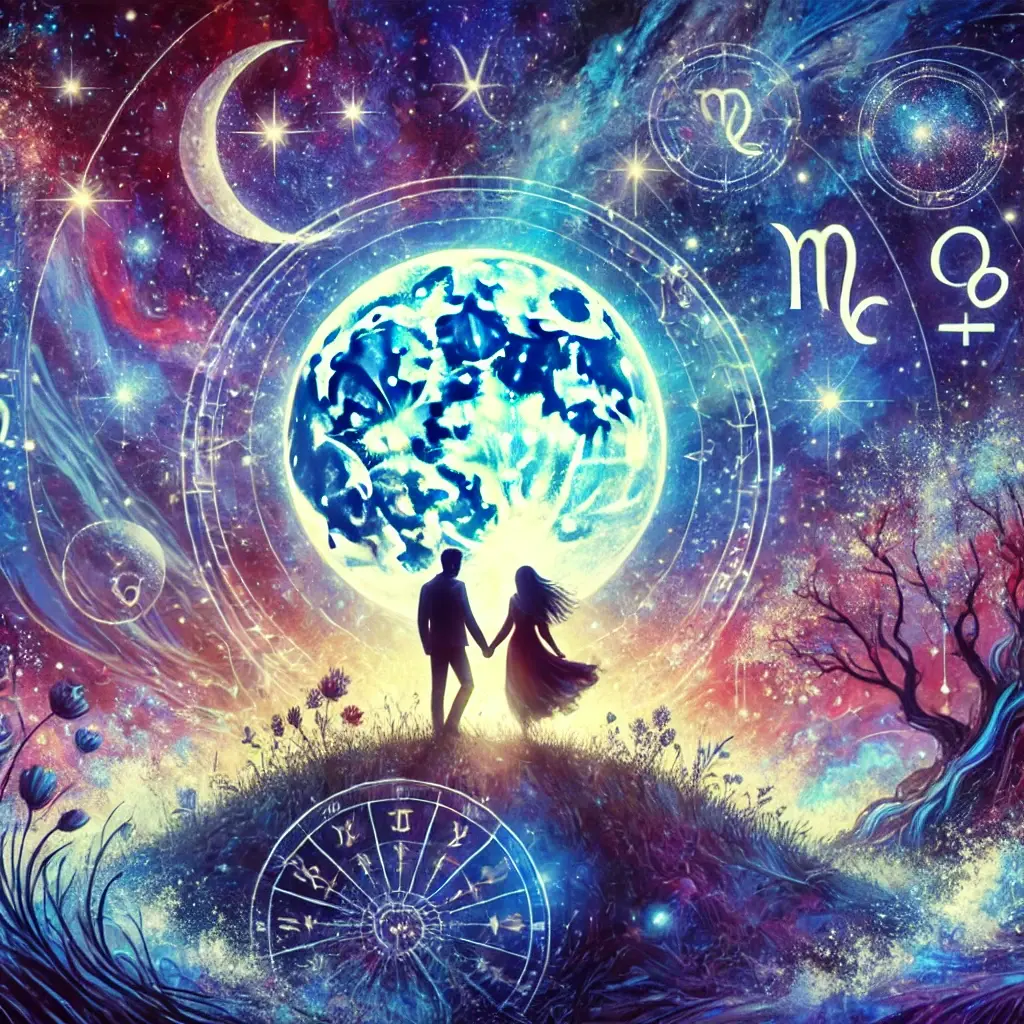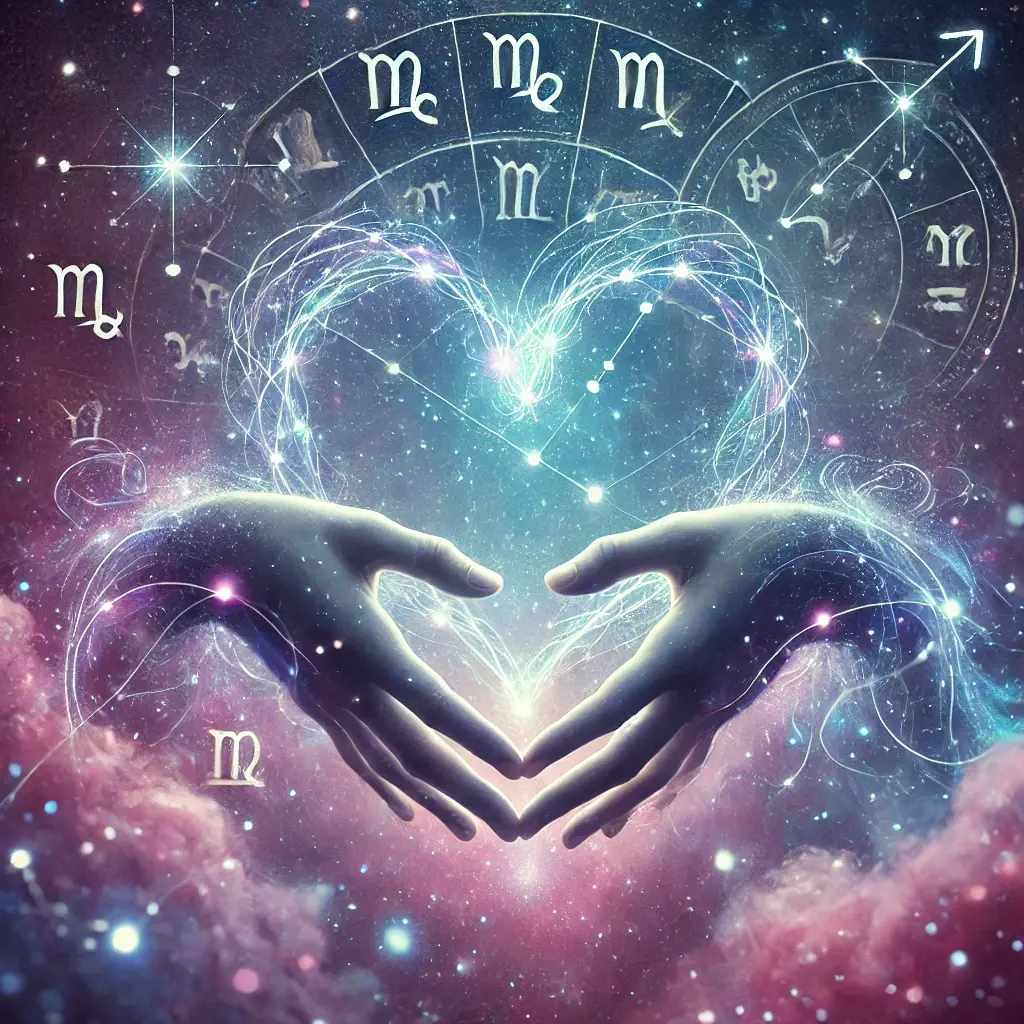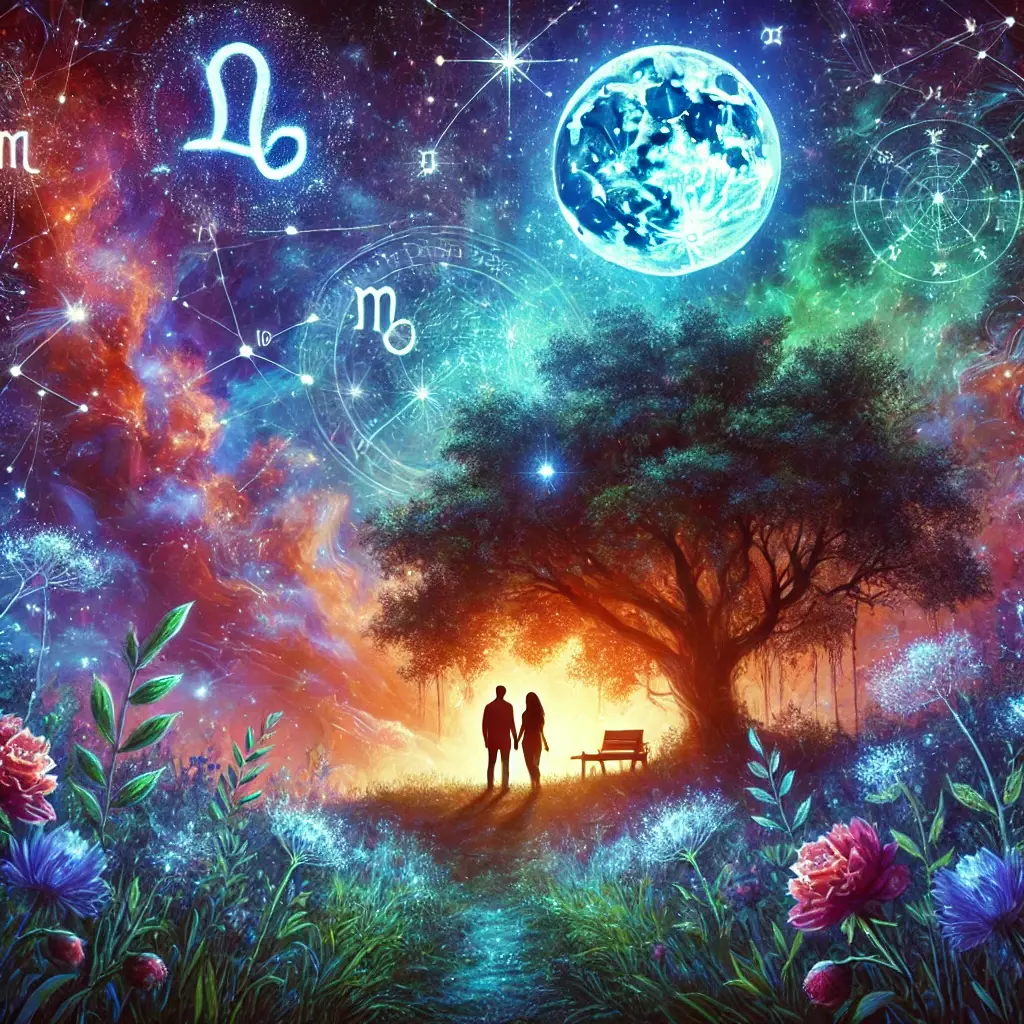The Celestial Dance of Love: Understanding Your Love Compatibility Through Astrology
Love, in its purest form, is a dance between two souls, each bringing their unique rhythm and energy. Astrology, an ancient art that studies the influence of celestial bodies on human affairs, provides profound insights into these romantic interactions. By understanding our love compatibility through astrology, we can navigate the intricate choreography of relationships with greater awareness and harmony. This guide will delve into how the positions of the planets, especially Venus and Mars, shape our love lives and how their interactions can predict relationship dynamics.

The Foundation of Astrological Compatibility
Astrological compatibility, or synastry, examines how two individuals' natal charts interact. The natal chart, or birth chart, is a snapshot of the sky at the exact moment of your birth. It maps the positions of the sun, moon, and planets, each occupying a specific zodiac sign and house. Key components of the natal chart include:
1. Sun Sign: Represents your core self and ego. It's the most familiar aspect of astrology, often referred to in horoscopes.
2. Moon Sign: Reflects your emotional nature and how you respond to feelings and experiences.
3. Venus Sign: Governs love, beauty, and affection, indicating your approach to relationships and what you value in a partner.
4. Mars Sign: Represents your drive, passion, and how you assert yourself, crucial for understanding romantic chemistry.

The Role of Venus and Mars in Synastry
In synastry, Venus and Mars play pivotal roles in determining romantic compatibility:
● Venus: Known as the planet of love, Venus dictates how we express affection, our relationship ideals, and what we find attractive. For example, someone with Venus in Taurus values stability and sensuality, while Venus in Gemini seeks intellectual stimulation and variety.
● Mars: Mars is the planet of passion and desire. It reveals how we pursue what we want, including romantic partners. Mars in Aries is bold and direct, whereas Mars in Cancer is nurturing and protective.
When comparing two natal charts, astrologers look at the aspects (angles) between these planets. Harmonious aspects, like trines and sextiles, suggest ease and mutual understanding. Challenging aspects, such as squares and oppositions, indicate potential friction but also opportunities for growth and dynamic interaction.
Sun and Moon Interactions
While Venus and Mars are essential for understanding romantic attraction, the Sun and Moon's positions in each partner's chart reveal deeper emotional and psychological compatibility:
● Sun-Sun Aspects: These aspects show how each partner's core self interacts. A Sun conjunction, trine, or sextile suggests a strong mutual understanding and shared goals. Conversely, a square or opposition can indicate differences that require compromise.
● Moon-Moon Aspects: These aspects reveal how each partner's emotional needs align. Harmonious Moon aspects create a nurturing and empathetic bond, while challenging aspects can lead to misunderstandings and emotional clashes.
Rising Sign and House Overlays
The rising sign, or Ascendant, represents your outward persona and first impressions. In synastry, the interaction between two rising signs can determine initial attraction and how each partner perceives the other.
House overlays occur when planets from one partner's chart fall into specific houses of the other partner's chart. These overlays provide insights into how each partner influences different areas of life, such as career, home, or social connections. For example, if one partner's Venus falls into the other's 7th house of partnerships, it suggests a strong focus on love and commitment within the relationship.

Major Astrological Aspects and Their Influence
Astrologers analyze major aspects between partners' charts to gauge compatibility:
● Conjunction (0°): Intense focus and unity. Planets in conjunction blend energies, creating a strong bond but also potential for conflict if the planets have opposing natures.
● Sextile (60°) and Trine (120°): These aspects indicate harmony and ease. Sextiles and trines suggest natural compatibility and mutual support.
● Square (90°): Tension and challenge. Squares can lead to conflict but also drive growth and transformation.
● Opposition (180°): Polarity and balance. Oppositions require compromise and understanding, as they bring opposing energies into the relationship.
Interpreting Synastry Charts
Interpreting synastry charts involves examining these aspects and understanding their combined influence. For instance, a couple with a Venus-Mars trine may experience effortless romantic chemistry, while a Sun-Moon square could challenge their emotional connection.
Composite Charts: The Relationship's Chart
In addition to synastry, astrologers use composite charts to study relationships. A composite chart combines two natal charts into one, representing the relationship as a single entity. It reveals the relationship's strengths, challenges, and overall dynamic.
Key points in a composite chart include:
● Composite Sun: The core identity of the relationship.
● Composite Moon: The emotional foundation and how the relationship feels.
● Composite Venus and Mars: Indicate the romantic and sexual dynamics of the relationship.
Practical Tips for Using Astrology in Relationships
1. Know Your Chart: Understanding your own natal chart is the first step. Recognize your strengths and challenges in relationships.
2. Compare Charts: Use synastry to compare charts with your partner. Look for both harmonious and challenging aspects.
3. Embrace Differences: Astrology can highlight differences, but it's essential to view them as opportunities for growth rather than obstacles.
4. Consult a Professional: For a deeper understanding, consider consulting a professional astrologer who can provide personalized insights and guidance.
Conclusion
Astrology offers a profound and nuanced way to explore love and relationships. By understanding the celestial dance of love through synastry and composite charts, we gain valuable insights into our romantic dynamics. Whether you're seeking to enhance an existing relationship or navigate the complexities of new love, astrology can be a guiding light, helping you align with the cosmic rhythm of the universe.
Affirmation: "I am open to love, and my heart is aligned with the cosmic rhythm of the universe."
Embrace this affirmation as you explore the celestial dance of love, allowing the stars to illuminate your path to deeper connection and understanding.
Love, in its purest form, is a dance between two souls, each bringing their unique rhythm and energy. Astrology, an ancient art that studies the influence of celestial bodies on human affairs, provides profound insights into these romantic interactions. By understanding our love compatibility through astrology, we can navigate the intricate choreography of relationships with greater awareness and harmony. This guide will delve into how the positions of the planets, especially Venus and Mars, shape our love lives and how their interactions can predict relationship dynamics.

The Foundation of Astrological Compatibility
Astrological compatibility, or synastry, examines how two individuals' natal charts interact. The natal chart, or birth chart, is a snapshot of the sky at the exact moment of your birth. It maps the positions of the sun, moon, and planets, each occupying a specific zodiac sign and house. Key components of the natal chart include:
1. Sun Sign: Represents your core self and ego. It's the most familiar aspect of astrology, often referred to in horoscopes.
2. Moon Sign: Reflects your emotional nature and how you respond to feelings and experiences.
3. Venus Sign: Governs love, beauty, and affection, indicating your approach to relationships and what you value in a partner.
4. Mars Sign: Represents your drive, passion, and how you assert yourself, crucial for understanding romantic chemistry.

The Role of Venus and Mars in Synastry
In synastry, Venus and Mars play pivotal roles in determining romantic compatibility:
● Venus: Known as the planet of love, Venus dictates how we express affection, our relationship ideals, and what we find attractive. For example, someone with Venus in Taurus values stability and sensuality, while Venus in Gemini seeks intellectual stimulation and variety.
● Mars: Mars is the planet of passion and desire. It reveals how we pursue what we want, including romantic partners. Mars in Aries is bold and direct, whereas Mars in Cancer is nurturing and protective.
When comparing two natal charts, astrologers look at the aspects (angles) between these planets. Harmonious aspects, like trines and sextiles, suggest ease and mutual understanding. Challenging aspects, such as squares and oppositions, indicate potential friction but also opportunities for growth and dynamic interaction.
Sun and Moon Interactions
While Venus and Mars are essential for understanding romantic attraction, the Sun and Moon's positions in each partner's chart reveal deeper emotional and psychological compatibility:
● Sun-Sun Aspects: These aspects show how each partner's core self interacts. A Sun conjunction, trine, or sextile suggests a strong mutual understanding and shared goals. Conversely, a square or opposition can indicate differences that require compromise.
● Moon-Moon Aspects: These aspects reveal how each partner's emotional needs align. Harmonious Moon aspects create a nurturing and empathetic bond, while challenging aspects can lead to misunderstandings and emotional clashes.
Rising Sign and House Overlays
The rising sign, or Ascendant, represents your outward persona and first impressions. In synastry, the interaction between two rising signs can determine initial attraction and how each partner perceives the other.
House overlays occur when planets from one partner's chart fall into specific houses of the other partner's chart. These overlays provide insights into how each partner influences different areas of life, such as career, home, or social connections. For example, if one partner's Venus falls into the other's 7th house of partnerships, it suggests a strong focus on love and commitment within the relationship.

Major Astrological Aspects and Their Influence
Astrologers analyze major aspects between partners' charts to gauge compatibility:
● Conjunction (0°): Intense focus and unity. Planets in conjunction blend energies, creating a strong bond but also potential for conflict if the planets have opposing natures.
● Sextile (60°) and Trine (120°): These aspects indicate harmony and ease. Sextiles and trines suggest natural compatibility and mutual support.
● Square (90°): Tension and challenge. Squares can lead to conflict but also drive growth and transformation.
● Opposition (180°): Polarity and balance. Oppositions require compromise and understanding, as they bring opposing energies into the relationship.
Interpreting Synastry Charts
Interpreting synastry charts involves examining these aspects and understanding their combined influence. For instance, a couple with a Venus-Mars trine may experience effortless romantic chemistry, while a Sun-Moon square could challenge their emotional connection.
Composite Charts: The Relationship's Chart
In addition to synastry, astrologers use composite charts to study relationships. A composite chart combines two natal charts into one, representing the relationship as a single entity. It reveals the relationship's strengths, challenges, and overall dynamic.
Key points in a composite chart include:
● Composite Sun: The core identity of the relationship.
● Composite Moon: The emotional foundation and how the relationship feels.
● Composite Venus and Mars: Indicate the romantic and sexual dynamics of the relationship.
Practical Tips for Using Astrology in Relationships
1. Know Your Chart: Understanding your own natal chart is the first step. Recognize your strengths and challenges in relationships.
2. Compare Charts: Use synastry to compare charts with your partner. Look for both harmonious and challenging aspects.
3. Embrace Differences: Astrology can highlight differences, but it's essential to view them as opportunities for growth rather than obstacles.
4. Consult a Professional: For a deeper understanding, consider consulting a professional astrologer who can provide personalized insights and guidance.
Conclusion
Astrology offers a profound and nuanced way to explore love and relationships. By understanding the celestial dance of love through synastry and composite charts, we gain valuable insights into our romantic dynamics. Whether you're seeking to enhance an existing relationship or navigate the complexities of new love, astrology can be a guiding light, helping you align with the cosmic rhythm of the universe.
Affirmation: "I am open to love, and my heart is aligned with the cosmic rhythm of the universe."
Embrace this affirmation as you explore the celestial dance of love, allowing the stars to illuminate your path to deeper connection and understanding.